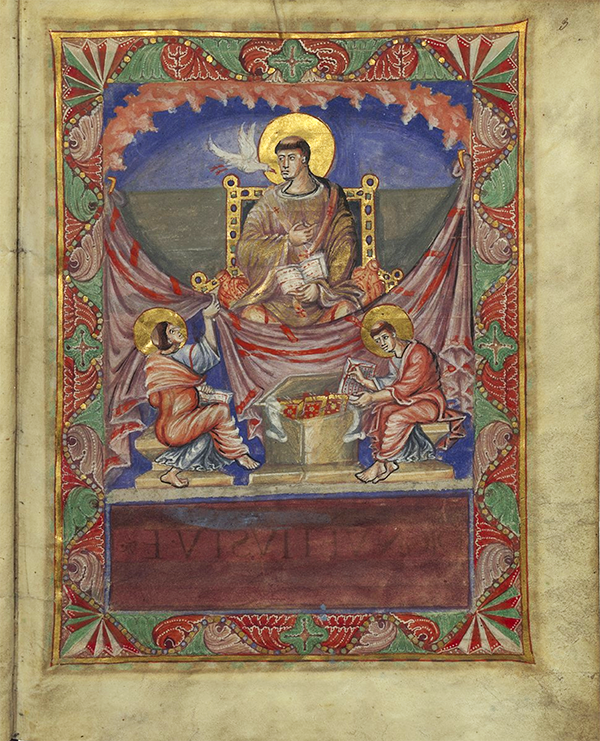This research project analysed connections between illuminated manuscripts and real, pictorial, imagined and metaphorical spaces. These connections include pictorial construction and visual perception of space in book illumination, the book itself as a spatial construct, and the way in which books as objects determine the perception of their surroundings, influencing the actions of those who handle and employ them.
Research

Illuminated manuscript. Pope Gregory I (Folio 3 recto) shown on the Sacramentary of Charlemagne, Carolingian (869-870) | Source: Bibliothèque nationale de France | Public Domain
The project encompassed the individual projects and research interests of Karin Gludovatz (late medieval illuminated manuscripts from the Netherlands and France) and Tina Bawden (early medieval manuscripts from the British Isles and Carolingian Francia). The main focus was therefore on Western Christian illuminated manuscripts from 700 to 1100 and from 1300 onwards. Within this project, focusing on individual case studies from the early and late traditions of illuminated manuscripts enabled comparison and contrast of the various relationships between book and space against the backdrop of different contexts of book production and reception.
Guided by the broad three-part structure (space in books, book as space, topography of books), the following fundamental questions were developed and addressed from a diachronic perspective, and discussed in reading groups, at workshops and conferences: What kind of space is the medieval manuscript codex? Throughout the Middle Ages, an understanding of the book in spatial terms is reflected in metaphors and in the layout of books. While the specific appearance awarded to “entrance” and “exit” pages has often been noted, the graphic and visual guidelines for movement through the book have attracted less attention. An international workshop organized in collaboration with Silke Tammen (Justus-Liebig-Universität Gießen) analysed the book as a hodological space:” Par chemin. Wege durch das illuminierte Buch” (November 22-23, 2013)
A second workshop addressed the resulting question: How does the space of the page relate to the space of the book? Organised in collaboration with Friederike Wille (Kolleg-Forschergruppe BildEvidenz, Freie Universität Berlin), this workshop examined interfaces between layout and space: “Topologie der Seite. Die mise en page im Raum des Buches” (July 18, 2014).
Aspects of sequence and structure within the manuscript were taken up in the workshop “Visual Rhetorics: Narrative and sequence in illuminated manuscripts” (August 1, 2018), and a further workshop discussed the third emphasis of the project, that of the spaces and furniture of book use: “Aspekte des Buchgebrauchs im frühen Mittelalter” (November 23, 2018). From the outset, the topic of the project entailed a shift of emphasis, from extracting textual and pictorial contents of books toward a recognition of their physicality. In consequence, this meant considering medieval manuscripts as objects. A session on the book as object organised by Karin Gludovatz and Tina Bawden at the 35th Deutscher Kunsthistorikertag in Göttingen (March 28, 2019) opened up the methodological implications of this shift for art historical discussion.
Results
Returning to the issue of pictorial representation of space on the basis of a methodological awareness of the materially and conventionally defined areas of medieval manuscripts led us to examine the pictorial techniques employed to construct or evoke space or spatial relations within the topology of the book. Three aspects turned out to be particularly fruitful in this respect: The way in which frames and framing devices set up spatial relations; non-formal ways of constructing space pictorially, for example topological functions of colour (results for some Anglo-Saxon manuscripts presented at the international conference “Clothing Sacred Scripture” in Zurich, October 2014); and the question of spatial implications of the alignment and ornamentation of script and monogrammatic initials (presented with regard to Insular and Carolingian manuscripts at the international conference on “Graphic Compositions and Monogrammatic Initials” at the Norwegian Institute in Rome, May 2015).
The continuation of Tina Bawden’s project “Topologies of the Codex: Space in Carolingian and Anglo-Saxon Illuminated Manuscripts” from November 2014 onwards was supported by the Freie Universität Berlin within the Excellence Initiative of the German Research Foundation. As Dahlem International Network Postdoc she spent six months as a Visiting Research Fellow at Leeds University, enabling her to foreground her work on Anglo-Saxon manuscript illumination. Recently, the ability to work with the Dr. Detlef Noack collection of facsimiles, donated to the Fachbereich Geschichts- und Kulturwissenschaften in 2015 has opened and will continue to open new avenues of enquiry with regard to the issue of the book as object as relevant to the study of manuscript illumination, not merely within this project, but also for the (under)graduate study of illuminated manuscripts which the project actively supports.
